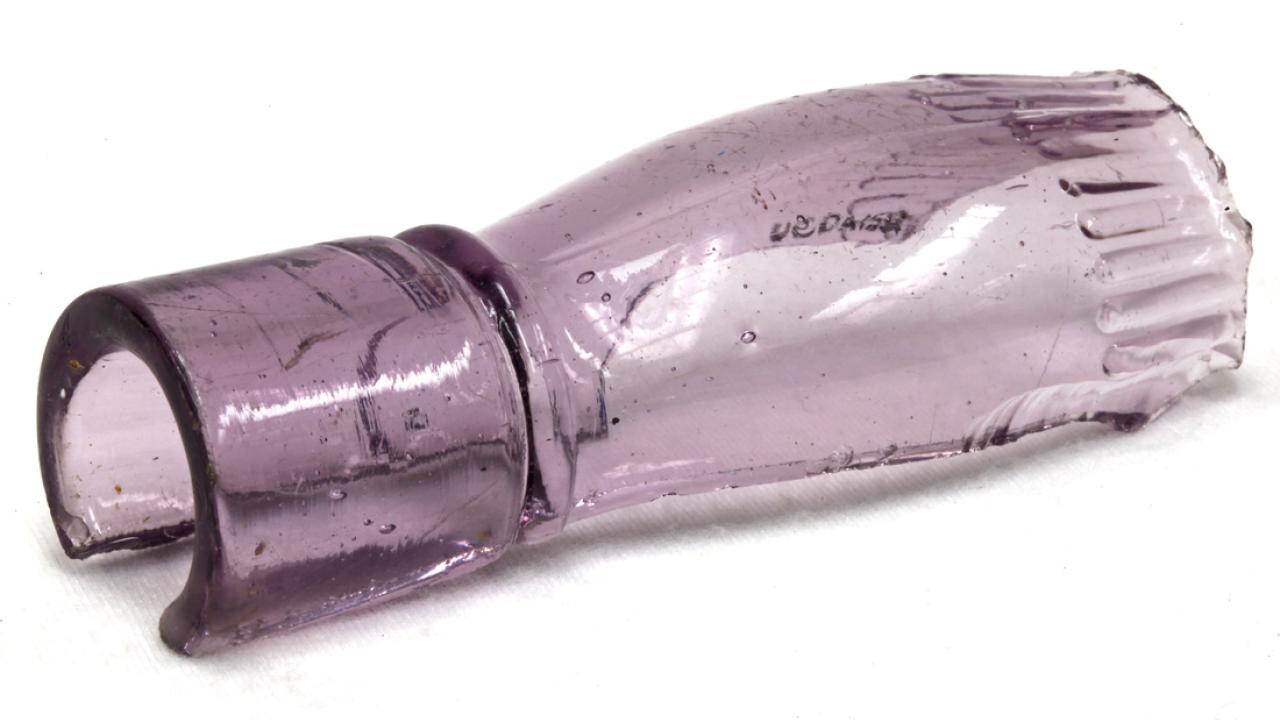
November 20, 2015: Solarized Amethyst Glass
Here’s an age-old question: how do you make glass clear? Glass has been around for a long time, but not like we know it today. The earliest known archaeological glass dates to around 3500 BCE, from Egypt and Mesopotamia, and is mainly opaque beads and ceramic glazes. Hollow glass vessels using core-molds are known from around 1600 BCE and later in Mesopotamia and Egypt, but the technique seems to have also been developing independently in Greece, China, and Tyrol (Austria). Blown glass and the use of exterior-molds, a technique developed by Syrian artisans, greatly increased the variety of glass vessels that could be produced.
As for the color of this glassware, it could vary greatly depending on the material being used. The raw material used to make glass is a mixture of formers, fluxes, and stabilizers. Formers are the bulk of the raw material, usually silicon dioxide collected as sand. Fluxes are materials used to lower the temperature at which the formers will melt, with the two main fluxes in glass production being soda (sodium carbonate) or potash (potassium carbonate). Stabilizers make the finished glass strong and resilient to water, and calcium carbonate is often used to achieve this task. Between the former, fluxes, and stabilizers, the glass’s raw material has a number of ingredients going into it, and glassmakers must have recognized that the color of their final product had something to do with the chemistry of their raw materials.
Decolorizing glass, or making it clear, was a goal that had varying degrees of success from the 7th century BCE to the 1st century CE in the Mediterranean. A method for making glass clear was eventually systematized in Alexandria, under the Roman Empire, around 100 CE and spread through the empire. The secret ingredient: manganese-rich minerals (such as pyrolusite).
We now know that pure silicate sand as a glass former has a naturally clear color when used to make glass, however iron impurities in the sand give it a range of green, blue, or yellow tints depending on the ratio of ferrous iron (blue-green in color) and ferric iron (yellow in color). Manganese dioxide (MnO2), which alone imparts a pink or red tint, oxidizes iron particles during glass making, and in its new oxidation state, iron gives only a slight yellowish hue. In its reduced state manganese dioxide is almost colorless. The result is clear glass.
While other forms of clear glass-making developed over the centuries, notably lead-crystal (which is a bit of a misnomer since glass does not actually have crystalline structure), using manganese dioxide as a decolorizer was commercially popular prior to and especially during the 19th and early 20th centuries. In the mid-19th century, people were noticing a strange phenomenon in the older houses in New England, some which had been around for a few hundred years. Clear glass window panes were beginning to develop a purplish hue to them. This phenomenon of glass solarization was studied by Thomas Gaffield (1825-1900), a New England glass manufacturer, who found that it was manganese dioxide as a decolorant that had this effect and that the effect could be reversed by heating the glass.
The reason for this solarization effect is that, when exposed to sunlight, the manganese dioxide slowly becomes photo-oxidized, bringing it back from the reduced state acquired from the iron interaction, and the glass slowly grows purple in color. Reducing the glass by heating can render it clear again, but the temperature needed to do so (between 450-500 degrees Fahrenheit) is close to the point of plasticization and is not recommended for artifacts.
For glass collectors in the United States, solarized amethyst glass is sometimes seen as a sign of artefactual authenticity of early American glassware, which led some sellers to leave glassware out in exposed sunlight or even artificially bombard their artifacts with ultraviolet light. Since the solarization process is proportional to the amount of solar radiation the glass received as well as the amount of magnesium dioxide in the glass, the amount of tinting has yet to serve as an effective archaeological direct dating method, although the presence of solarized glass at all is a loose dating method. Manganese, which was largely imported from Germany, fell out of favor for domestically produced selenium around the time of the First World War, around the time of the first automated bottle machine, which favored the selenium decolorant. From around 1917-1933 selenium surpassed and all but replaced the use of manganese dioxide, which can help distinguish historical archaeology from the time period.